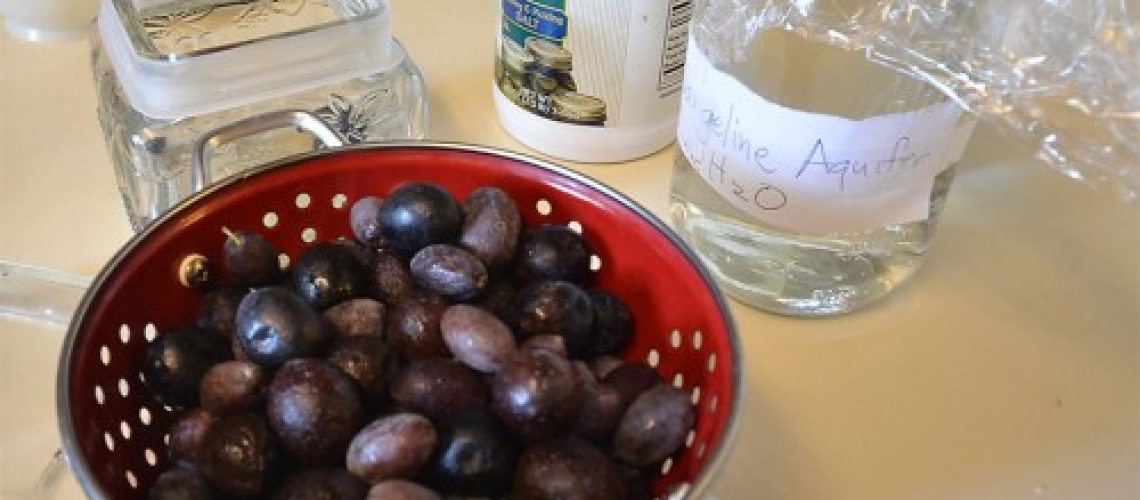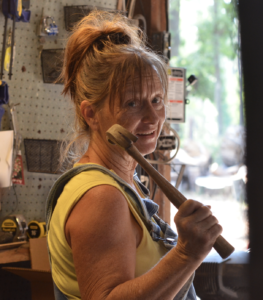“I’ve got a small package of olives. I don’t know how good they still are. I’ll get them for you if you want to try”.
WM and his wife had planted olive trees on their place, a little north of Houston proper. Sowed up on high mounds of soil, they had avoided the quagmire of trying to plant anything directly into the Gulf coast clay gumbo and the gnarly limbs and even gnarlier roots of their olives tree had a good hold. Their trees have been producing medium sized olives for several years and it takes years for an olive to mature to the point it’ll makes its bitter little fruit.
“Bring them. I want to try,” I told him picturing the olives I had tasted only last year.
‘You’ll need well water,” WM states, and handed me a gallon from his well.
Now olives intrigue me, I thought as I drove home from their place, a small ziplock bag full of ripe black olives each about the size of my thumbnail on the seat beside me. This same family had given me three olive trees to plant at the farm and I monitor my plants enough to know that two of them were eking out a living on the hillside south of the pond.
They made it through the worst drought in Texas history last summer. They are tough plants. Some are documented to live 2000 years. If you hack the tops off, shoots will grow from the roots below.
I have a healthy respect for these evergreen Mediterranean natives with their silvery leaves.
I’m also quite fond of their fruit and oil.
People have been ‘curing’ olives since the plant was cultivated and my plan was to try my hand at it.
Unseen, but present on every olive, back 2000 years ago or now, are small bacteria of all kinds. They have company. Floating in the air, tiny, microscopic yeasts drawn to anything sweet, float about and then colonize the crevices of plants and fruits of a garden, and these olives.
I looked at that bag. Inhabiting and unseen, were all manner of bacteria and yeast, reproducing and ingesting whatever tiny molecules their tiny little metabolisms could handle. It was my job to select those I preferred for the current task and use their capacities to my advantage.
Gently scoring each olive to allow the brining solution I made to infiltrate, I was about to set the stage for the ‘right’ kind of bacteria to begin their microscopic buffet. My plan, which has been the plan of generations of traditional olive curers, was to set the table for a particular kind of bacteria and yeast that would spend the rest of their lives churning any sugars into lactic acid. Pooping out acid, lactic acid (well not actually pooping because none of these things have an anus) their waste products would build up in the salty brine (which my target tiny dinner guests LOVE by the way) and three good things were going to happen. The pooped in solution would PULLLL the bitterness out of each olive, the lactic acid would keep any other bacteria from growing that might cause the olives to rot, and a whole suite of very flavorful compounds would take take up residence in the olives.

“That was a good idea about the well water”, I thought to myself as I poured the solution into the olives. That water had only the chemicals that rain water from central Texas percolating underground till it came to pool 800 feet below Houston could have. It was water, clear, clean water from the Angelina Aquifer.
My, my, my microbial zoo was in for a geochemical, hydrological, treat.
Olive brining is a process. For three weeks I checked their progress, changing their brine, and skimming the yeasty, bacterial pelicle that formed.

Sticking my nose close to the top, today they smelled olive-y. They smelled good. Done, I picked one to taste.
These are good, I think as I down the little zoo and drupe in one bite and consider the nice salty flavor and something more.
It takes a village… in the form of a friend and a microbial zoo. If we’re talking about olives that is.
Olive brining is a good experiment. Should you ever have a friend that offers you olives, take them. Try your hand at it. It’s always good to expand your horizons, especially when it requires you consider the small things.
If you are into science and olives…
http://pineknotfarmandlab.com/?attachment_id=3146






7 Responses
ABSOLUTELY FASCINATING.
This is the first time I’ve read one of your pineknotfarms excerpts. Loved it!! Took an olive off a tree in Italy and thought it wasn’t ripe. Who knew!
As detailed as ever, very interesting. My Uncle Jaime and their family had a grocery store in Puebla Mexico. He remember when growing up going to the port of Veracruz and buying from almost nothing the barrels full of olives that the ships cooing from Spain or Italy carry as balast…
Godspeed,
Girlfriend, you make everything sooo interesting! Love,love, love this article and the pictures. But only you can make such an experiment so colorful! Now, I’m on the hunt for olives to try it for myself. When I find them, you’ll have to share more detailed instructions. And did yours come anywhere close to tasting like those in Greece? 🙂
You always impress me. Going to the fridge to eat some black olives.
I’ve never met an olive that I didn’t like but never considered the hidden “world” that makes their flavor. Your excerpt also brings me back to sweet memories of the hillsides in Italy dotted with olive trees skirted with netting to catch each tree’s treasures.
We’ve missed seeing you at LTL. Come share lunch one day soon?
I don’t know Janet, they sure look nasty to me. I’m not too sure I want to know everything about what I eat. Sometimes things taste better to me when I don’t know about the “bacteria and poop”. 🙂